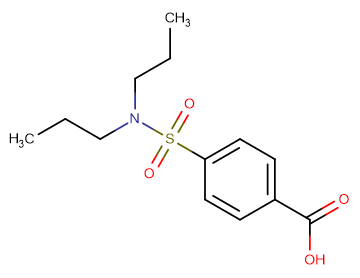
Probenecid
CAS No. 57-66-9
Probenecid( NSC 18786 )
Catalog No. M15105 CAS No. 57-66-9
The prototypical uricosuric agent. It inhibits the renal excretion of organic anions and reduces tubular reabsorption of urate.
Purity : >98% (HPLC)
 COA
COA
 Datasheet
Datasheet
 HNMR
HNMR
 HPLC
HPLC
 MSDS
MSDS
 Handing Instructions
Handing Instructions
| Size | Price / USD | Stock | Quantity |
| 1G | 45 | In Stock |


|
Biological Information
-
Product NameProbenecid
-
NoteResearch use only, not for human use.
-
Brief DescriptionThe prototypical uricosuric agent. It inhibits the renal excretion of organic anions and reduces tubular reabsorption of urate.
-
DescriptionThe prototypical uricosuric agent. It inhibits the renal excretion of organic anions and reduces tubular reabsorption of urate. Probenecid has also been used to treat patients with renal impairment, and, because it reduces the renal tubular excretion of other drugs, has been used as an adjunct to antibacterial therapy.
-
In Vitro——
-
In Vivo——
-
SynonymsNSC 18786
-
PathwayMembrane Transporter/Ion Channel
-
TargetTRP/TRPV Channel
-
RecptorTRPV2
-
Research AreaMetabolic Disease
-
Indication——
Chemical Information
-
CAS Number57-66-9
-
Formula Weight285.36
-
Molecular FormulaC13H19NO4S
-
Purity>98% (HPLC)
-
SolubilityEthanol: 22 mg/mL (77.09 mM); DMSO: 57 mg/mL (199.74 mM)
-
SMILESCCCN(CCC)S(=O)(=O)C1=CC=C(C=C1)C(=O)O
-
Chemical Name4-(dipropylsulfamoyl)benzoic acid
Shipping & Storage Information
-
Storage(-20℃)
-
ShippingWith Ice Pack
-
Stability≥ 2 years
Reference
1.McDonough PM, et al. Cell Calcium, 1989, 10(3), 171-180.
molnova catalog



related products
-
HC-070
HC-070 is a TRPC5 and TRPC4 antagonist (IC50 = 9.3 nM and 46 nM).
-
ASP7663
ASP7663 is a?TRPA1 Receptor Agonist?and exhibiting an abdominal analgesic effect in vivo.?
-
MDR-652
MDR-652 is a highly specific and efficacious agonist of nonpungent transient receptor potential vanilloid 1 (TRPV1) with Ki value of 11.4 nM and 23.8 nM for hTRPV1 and rTRPV1 respectively and EC50s for hTRPV1 and rTRPV1 are 5.05 and 93 nM respectively.



 Cart
Cart
 sales@molnova.com
sales@molnova.com


